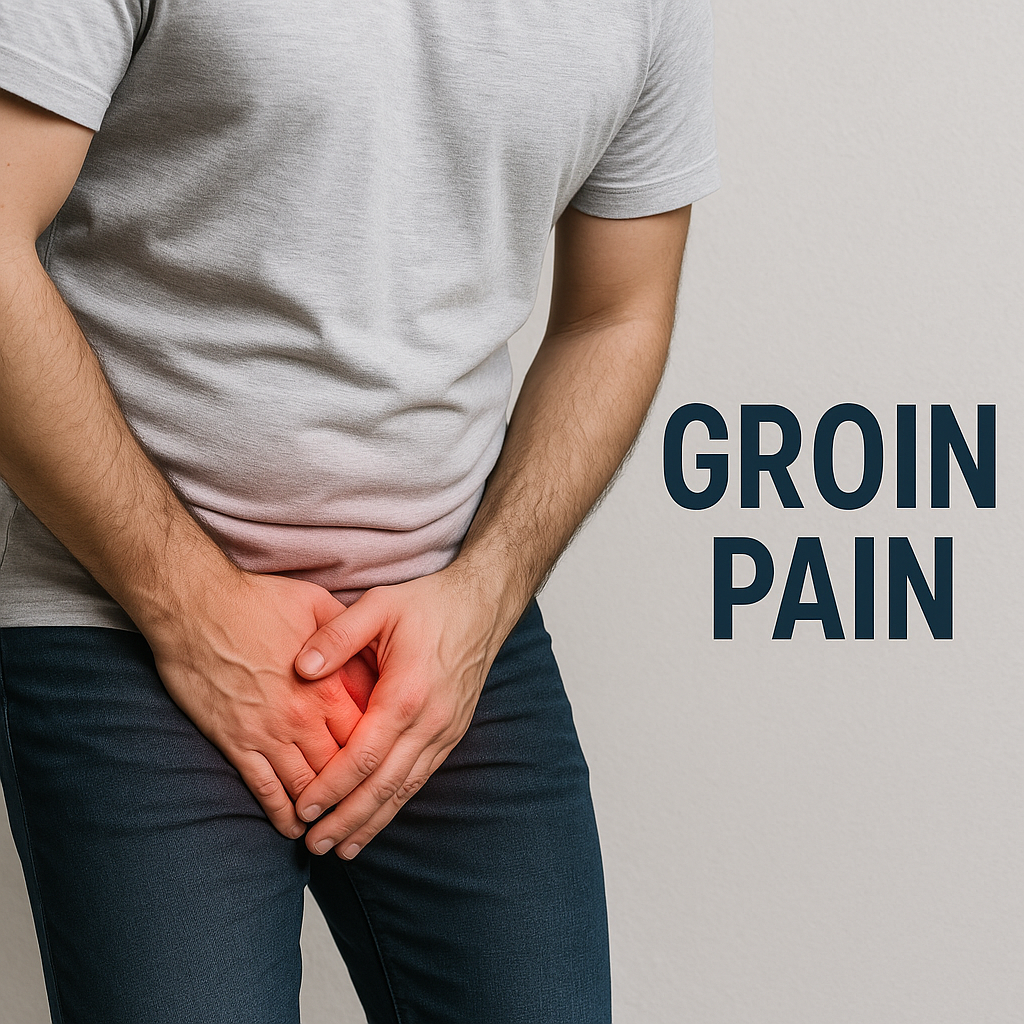What is Groin Pain?
Groin pain refers to discomfort or pain in the lower abdomen, inner thigh, or pelvic area, where the upper leg meets the pelvis. It can arise from muscles, tendons, joints, nerves, or
internal pelvic structures. Groin pain may develop suddenly due to injury or gradually from chronic strain, surgery, or underlying conditions.
It is important to identify the true source of the pain — which may be musculoskeletal, nerve-related, or visceral — as treatment will vary depending on the underlying cause.

What are the symptoms?
You may experience:
- A dull ache, sharp pain, or burning sensation in the groin
- Pain aggravated by movement, coughing, or standing
- Radiation of pain into the inner thigh, lower abdomen, or genitals
- Numbness or tingling, suggesting nerve involvement
- Pain after surgery, e.g. hernia repair, C-section, or appendectomy
What are the common causes we assess?
We manage groin pain from a non-surgical, nerve-related or musculoskeletal origin, including:
- Ilioinguinal or iliohypogastric neuralgia (nerve entrapment or post-surgical pain)
- Genitofemoral neuralgia (burning pain radiating into the groin or upper thigh)
- Obturator neuralgia
- Myofascial trigger points in pelvic or abdominal wall muscles
- Post-surgical pain (e.g. after hernia repair, pelvic surgery, or hip replacement)
- Referred pain from the lumbar spine or sacroiliac joints
We do not assess or treat groin pain due to hernias, gynaecological, urological, or gastrointestinal conditions — these should be evaluated by your GP or relevant specialist.
How is it diagnosed?
Diagnosis includes:
- A detailed clinical history and physical examination to identify likely pain generators
- Neurological and musculoskeletal assessment of the lower spine, hip, pelvis, and abdominal wall
- Diagnostic imaging may be reviewed, but pain often relates to nerve or soft tissue causes not visible on scans
- Diagnostic nerve blocks can help confirm the involvement of specific nerves
What to expect from treatment
- Our goal is to reduce pain, improve mobility, and support your return to normal activities
- All treatments are minimally invasive, outpatient-based, and tailored to your individual presentation
- We also support rehabilitation and pacing advice, often needed for persistent or post-surgical groin pain
What treatments do we offer?
We offer targeted, image-guided treatments based on the underlying cause:
1. Peripheral Nerve Blocks
- We offer blocks for:
o Ilioinguinal and iliohypogastric nerves
o Genitofemoral nerve
o Obturator nerve - These injections use local anaesthetic, sometimes with a steroid, to reduce nerve Irritation and confirm the pain source
2. Pulsed Radiofrequency Treatment
- If nerve blocks are effective but short-lived, pulsed radiofrequency may be considered for longer-lasting relief without damaging the nerve
3. Trigger Point Injections
- For myofascial or muscle-related groin pain (common in myofascial pain syndrome or fibromyalgia), we offer trigger point injections to deactivate painful knots in the abdominal wall, hip flexors, or adductors
4. Sacroiliac Joint Injection
- When groin pain originates from pelvic joint dysfunction, we may offer image-guided sacroiliac joint injections
Medication Optimisation
We offer a structured review of your current medications to ensure they are safe and effective. In line with local prescribing guidelines, we do not prescribe opioids or pregabalin. These must be managed by your own GP. We can provide recommendations to support safer alternatives and deprescribing where needed.
What we do not offer
- We do not manage surgical causes of groin pain such as hernias or gynaecological/urological conditions
- We do not prescribe opioids or pregabalin, in line with local prescribing policy
- We do not provide emergency pain services
